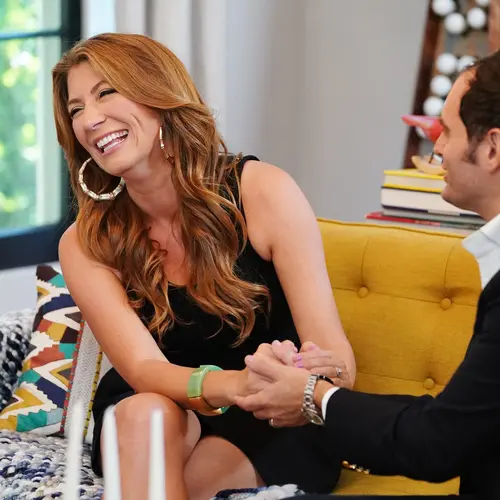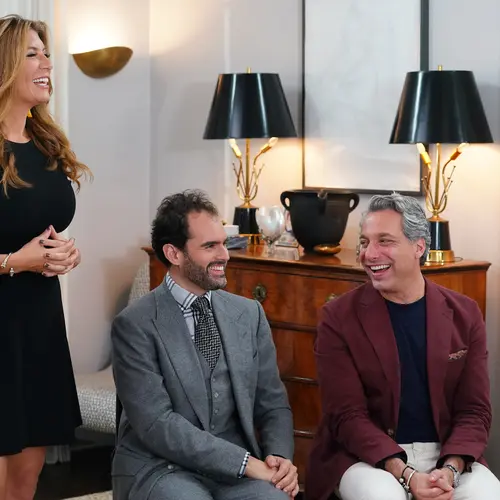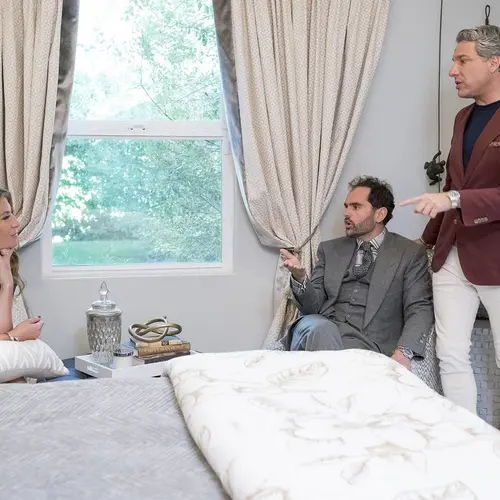Interview: Design star Genevieve Gorder on ‘Trading Spaces,’ her new show, and life in NYC
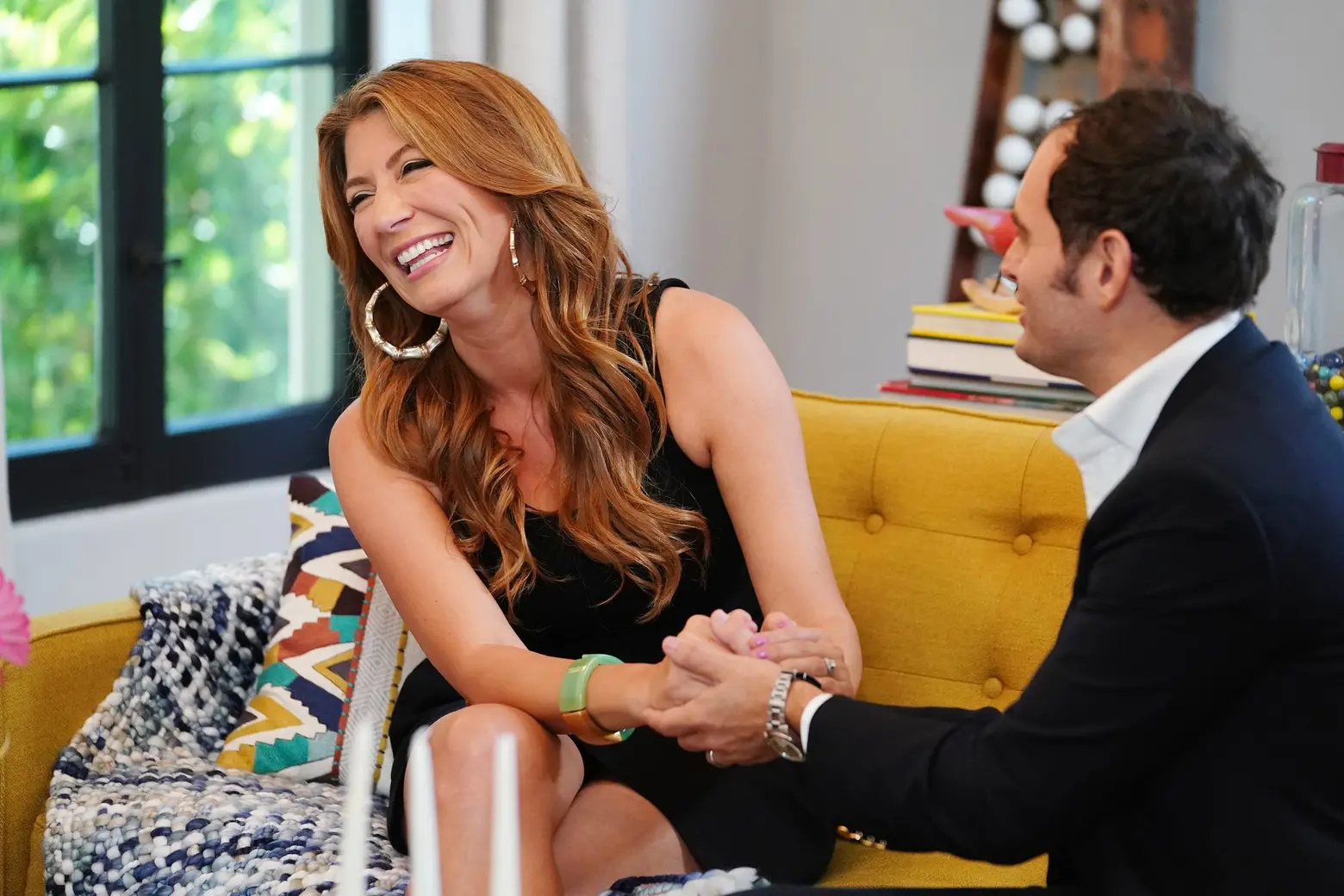
Genevieve Gorder on the set of “Best Room Wins” with Elle Decor Editor-in-Chief Whitney Robinson. Photo by Nicole Weingart/Bravo.
From getting her first design job at MTV during the station’s height in the ’90s to being selected as one of the original designers on TLC’s “Trading Spaces,” Genevieve Gorder says she feels eternally grateful for her timing. “I hit a lot of those key moments at the right time for when I was born, and I don’t know how I keep doing it, but I’m very grateful I do.” When Genevieve says she’s “grateful,” we know it’s authentic. This is why the interior designer has achieved the success she has, appearing in more than 20 TV shows over her 20-year career. She’s a person everyone feels comfortable around, whether it’s with a family who shares her Midwestern roots or a New York City neighbor.
Her latest endeavor, the design show “Best Room Wins,” aired last week, and once again, it’s Genevieve’s warmth, grace, and exceptional talent that are on full view. 6sqft recently caught up with Genevieve to learn more about her background and time on “Trading Spaces,” why she feels the new show is “smarter, sexier, and more real,” and what her favorite spots in the city are.
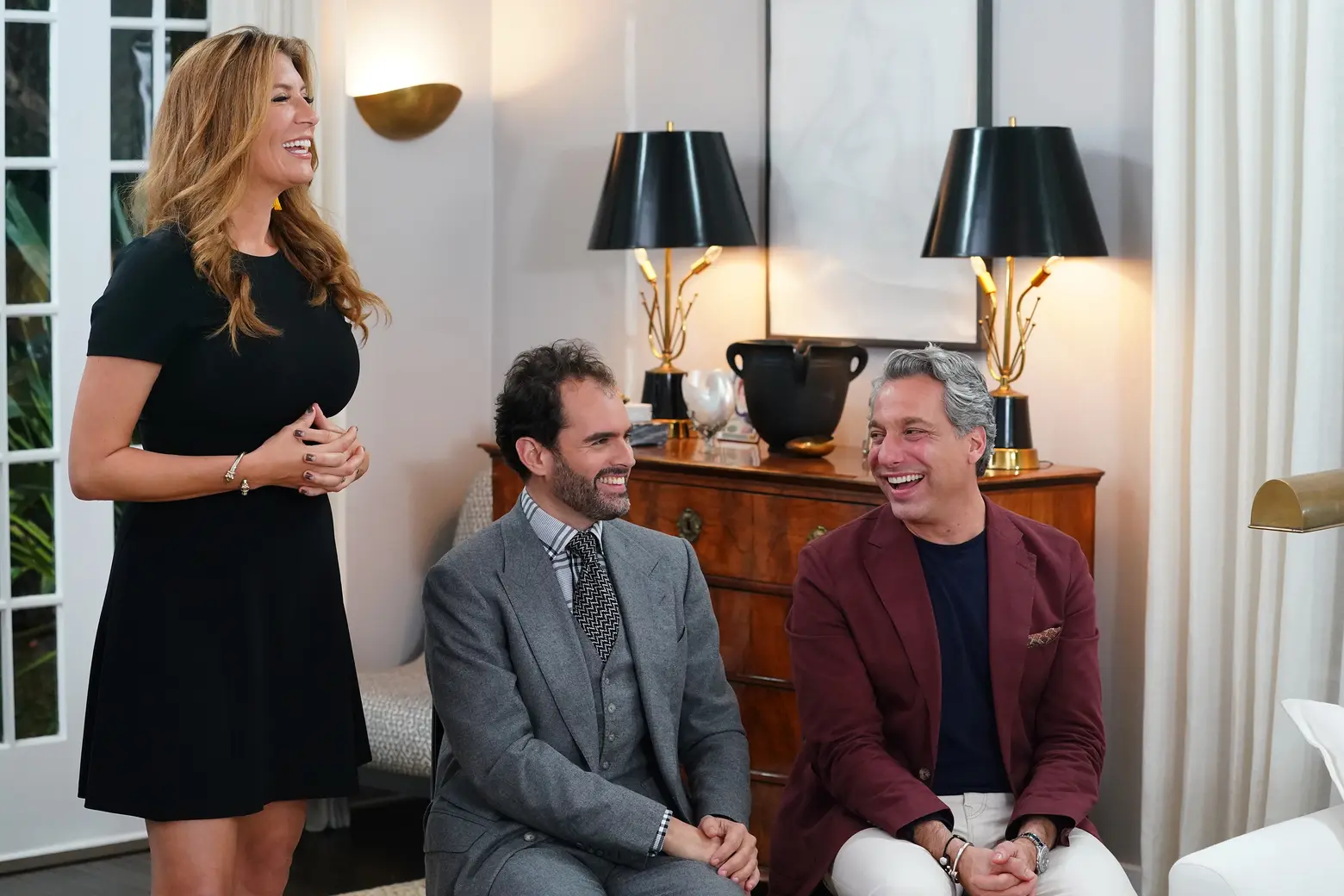 Genevieve Gorder on the set of “Best Room Wins” with Elle Decor Editor-in-Chief Whitney Robinson (center) and celebrity designer Thom Filicia (right). Photo by Nicole Weingart/Bravo.
Genevieve Gorder on the set of “Best Room Wins” with Elle Decor Editor-in-Chief Whitney Robinson (center) and celebrity designer Thom Filicia (right). Photo by Nicole Weingart/Bravo.
What brought you to NYC?
I grew up in Minneapolis. I’m the oldest of three. A lot of my family is from the East Coast, so we all had a very fast way of talking for a slower spoken place. I first went to Oregon for college thinking I was going to go into International Affairs. I was an exchange student and spoke a lot of languages and thought, oh, yes, I’m going to be a diplomat. And I quickly learned I wasn’t.
I had done a lot of interior design with my family, renovating homes, mostly American Foursquares, Queen Anne’s, a lot of turn-of-the-century architecture in Minneapolis. I found design and was like oh, this comes in handy, all this stuff I learned as a kid. It was effortless; I had that moment at 17 where I knew exactly what I would be doing the rest of my life.
And so I came to New York and went to the School of Visual Arts. I got a job at MTV when I was 18, and I worked there for five or six years while I was going through school. I was doing a lot of graphics and sets, everything from the trophies for the Video Music Awards to the little Ms that we had to fill in with a million different things to invites to cards that you would read when they would win something. It was limitless. At that time at MTV when they were still doing music–it was a moment.
How did you then land on “Trading Spaces?”
I finished MTV and studied in Holland. I worked there and graduated from art school. And then I got a job right away in a studio in New York. We were doing interiors and brand identity. It was a very high-end, award-winning studio which was actually from Minnesota where I grew up. So it was like everything in one in New York, and I was so happy. I wasn’t punished for my accent.
I had just won an award for Tanqueray Ten. I designed the bottle, and it was beautiful. I was 23. I didn’t even like gin, but this was a case where [the company] believed that design would create money and they were right. After I designed that, it won all these nerdy awards in the design community that no one would know about or care about. But Trading Spaces happened to be casting and was looking through award annuals and they called up five or 6,000 of us, not knowing what we looked like, if we could speak, if we could do interiors necessarily.
They chose six of us, and off we went into orbit. You have to think somebody somewhere up there was doing this, which was kind of preplanned. Because TV wasn’t an option for us; it didn’t exist. There was only “This Old House” and “Martha [Stewart].” (I loved them both.)
It must have been quite an experience to be one of the original designers.
It was, yes. I was just out of college. We were on a tour of our country in a way that I’ll never have the opportunity to do again. It was like a rock tour with design and we got to see how everyone lived.
Now that the show has come back, I think what’s resonated with people is how the cast really grew close and stayed in touch.
In the beginning, there was a variety of different age groups, and we were all pulled from complete obscurity. We did something that was being done for the first time in our country and it wasn’t just a show. It became truly a movement. We went through this extraordinary time together and came into this world of entertainment in a way where cameras followed you and you got written up in tabloids. We weren’t prepared and we had each other and only each other, really, in the whole world. I couldn’t call up Martha (laughs). So it was a bond that’s kind of indestructible even though we’re incredibly different. Of course, people fought all the time and loved on each other and all of it, just like any family. But coming back now as grownups, [I have] truly a devout love for each and every one of them. No matter how dysfunctional a relationship we have with each other, we would fight tigers for each other, which I hope comes through.
Is there anything else that you think has made the show withstand the test of time?
I think it’s a relationship with generations of people. We brought design to kids in a way where they decided to become designers. I don’t know how many times I’ve heard that. That’s one of the most rewarding compliments there is. Or that you simply deserve beautiful things, and you don’t have to be wealthy to have them.
Since “Trading Spaces” you’ve done 22 other television shows. What do you feel is the reason for your success?
If it was a formula I would bottle up and sell it (laughs). I think there are a few things that I abide by that work for me, especially dealing with the home because it’s kind of the epicenter of culture. When you get invited into someone’s home, you truly understand where you are in the world. So I treat it with great respect. But “grace” is a really important word to me. To attack home design you have to have a sense of grace and that means listening, kindness. I believe that truly pays you back.
I am not a flash in the pan. I’m a long-term girl. So while a lot of things happened very quickly and the offers were there for me, I wanted relationships that were real and authentic to me as a person; maybe that’s a Midwestern thing. And as a trained designer, I also need to make sure that it’s always authentic to our field. Because TV isn’t always. Whatever I choose to do, like this latest show, it’s absolutely real. The language is real and the designers are real and they’re not just playing one on TV.
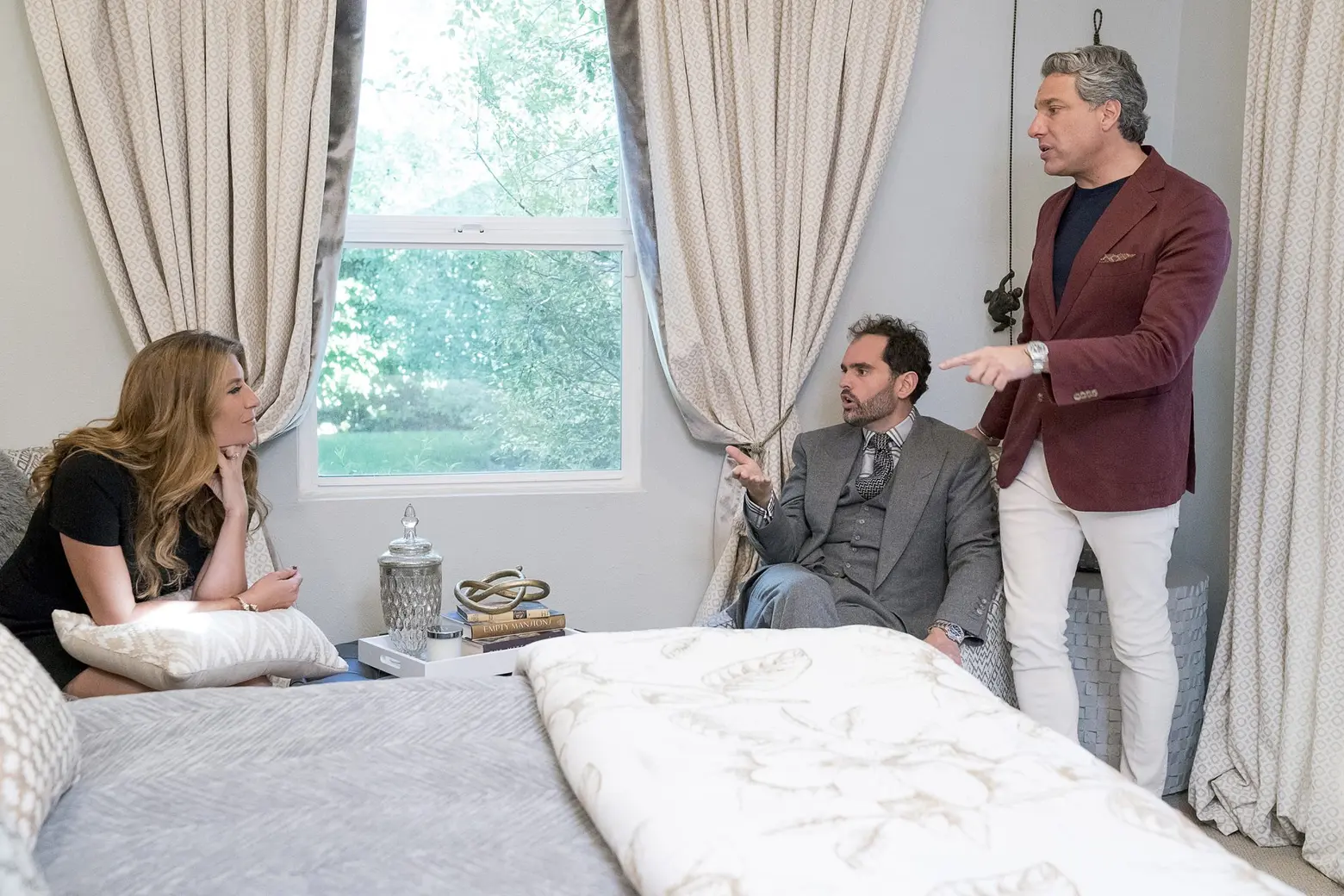 Genevieve Gorder on the set of “Best Room Wins” with Elle Decor Editor-in-Chief Whitney Robinson (center) and celebrity designer Thom Filicia (right). Photo by Nicole Weingart/Bravo.
Genevieve Gorder on the set of “Best Room Wins” with Elle Decor Editor-in-Chief Whitney Robinson (center) and celebrity designer Thom Filicia (right). Photo by Nicole Weingart/Bravo.
Speaking of success, your new show on Bravo, “Best Room Wins,” premiered last week. The catchphrase is “million dollar looks without the million dollar budget,” which seems to really resonates with people.
Yes. [Home] is the most expensive category of design that there is, period, and it’s the hardest to do on television, not just because I do it, but because we’re changing architecture in a week, not making a meal. It’s a big deal and it’s expensive. I think what’s important is that people understand there are a variety of different prices to do home. If you want to DIY it, there are those shows. If you want to buy the couch and buy the dining table and hire a designer, here’s that real price point, not lying about how much things cost.
These budgets felt very meaty to me at $25,000. But I think it’s inspiring and also completely approachable, which is always what you worry about with increasing the budget. Is a big part of the audience going to look away because like that’s too much? I think everyone can take something from this. We know what a sofa costs in this country, so let’s talk about it. If we don’t get it from Craigslist how much does it really cost? And what should we buy from Craigslist even when we have a big budget. Just because you have more money doesn’t mean you should spend it unwisely. Creativity is free. Style is free. So if you have that in the room, show me how clever you can be. Sometimes design can get to that place on television and off, of just glorified shopping. No, it’s an art form. It’s proportion and scale. It’s balance. It’s space planning. It’s sculpture. It’s color. It’s every piece of art in one big ball.
The designers take inspiration from actual multi-million-dollar properties, right?
Yes, so there’s a voyeuristic piece of this in that we are touring some of the most incredible examples of each style that we’re attacking, whether it’s traditional, modern, contemporary, neoclassical. And these inspiration homes, are $30 to $50,000,000 easily. [The designers] are taking inspiration from that house and going to a regular house anywhere in L.A. and doing one space for $25,000 in that style. So whatever we saw in the inspiration house they have to execute in the competition house.
How did you select the designers to work on the show?
[The production company] chose great contestants who could actually perform. I don’t think most designers can do what we ask in five days. These are really great designers already, trying to graduate into that utmost echelon, the upper tier, which “Elle Decor” is for us. It’s kind of our industry maker. And all these designers are trying to make that next step, so you’re seeing them do that in many different ways and some that are so clever. I want to see things that I haven’t seen, and I’ve seen a lot.
Let’s chat a little bit about NYC. You live in Chelsea?
I bought in Chelsea in 2004, but I had rented in [the neighborhood] prior to that. I think I’ve lived in every single neighborhood on the West Side; the light is better on that side. No one wants the morning light. I want the all-day light! I love the village-y aspect of living [in Chelsea]. I know everyone by name. I can’t say that about a lot of cities in America much smaller than ours.
What are some of your favorite spots in the neighborhood?
Oh my God, so many. What do you want to know? Nest Interiors is incredible. They’re on Ninth Avenue between 21st and 20th. Lovely couple with incredible taste. I buy stuff from them all the time. Juban Sushi is off the hook on 22nd and Tenth. I get coffee and pastry at La Bergamote, a French bakery. I think in the city it’s won every award possible. If you can eat gluten hit it hard. I love the cake decorating store on 22nd. I go there and get inspired. I will buy a few things, and then we’re like okay, we have to make something with these new things. And then, of course, Dickson’s. Their shop in Chelsea Market is my go-to for all meat.
Obviously, the High Line is right there, but you can only go on it at night if you’re a New Yorker (laughs). I love the riverfront, too. It feels like we have this front yard. At sunset, we all go down. I have so many friends in the neighborhood. At this point, we’ve all just kind of naturally gathered there. And we’ll have wine in a thermos and sit on the big lawn and watch the sunset on the West Side. It’s pretty epic. There’s a carousel. Our kids get on that so we have adult time.
Okay, last question. I know you featured your own home makeover on “Genevieve’s Renovation” in 2014, but for our readers who aren’t familiar, tell us a bit about your personal style.
I would say there’s definitely an American classic, pre-war classic [feel to my home]. When New York was buzzing and all of those old skyscrapers were built–the mullions, the iron, the black, the industrial age. I very much embody that style in the shell of my house. I have to honor the architecture where I live in my neighborhood. My house is 1850s. I started there and probably ended around 1920 just in the shell, and then the interior is ancient global. I love ancient fabrics, whether it’s Middle Eastern, whether it’s Moroccan. I definitely have a flair for the East, specifically Northern Africa. So you’ll see a lot of brass, a lot of hamam plates and the low tables and poofs. It’s a more languid way to laze then European or American. They’ve just got laze down the best. But I’m very sentimental about what I place as art or objects and sculpture in my house and that is usually telling a story about who am I tangibly. So where I’m from in Minnesota, where my ancestors are from, they’re all honored in this church that is my house.
Best Room Wins airs Wednesdays at 10/9c on Bravo.
RELATED:
- INTERVIEW: AphroChic’s founders pursue a passion for storytelling, design, and African American history
- INTERVIEW: Holiday House founder Iris Dankner supports cancer research through interior design
- INTERVIEW: Co-founder of the Brooklyn Home Company, Bill Caleo
This interview has been edited and condensed for clarity
